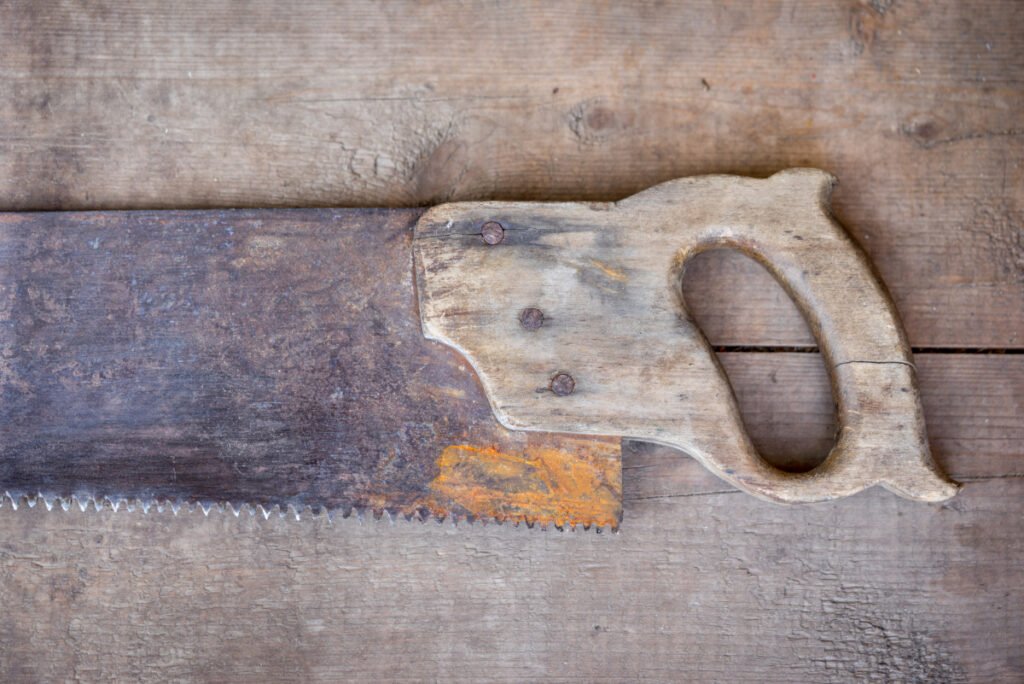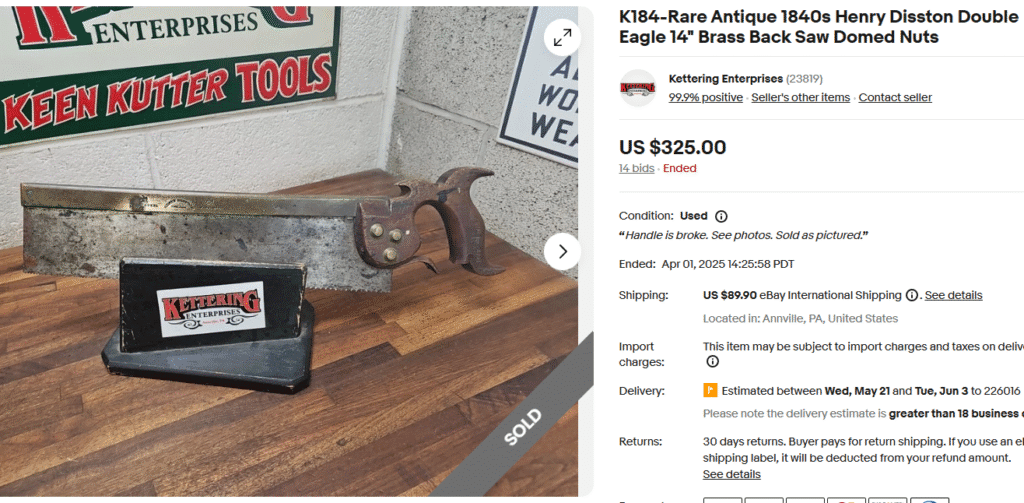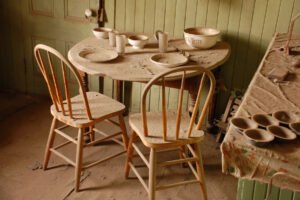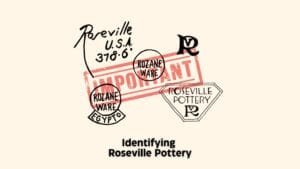If you found an old handsaw lying in your shed, it just might be your lucky day! Why? You may not know, but you can coin good money with authentic ancient and antique hand saws. But hey! You won’t get money just because your saw’s old!
There are many other factors, like its features, date, and type, that are important to judge whether a hand saw is antique or not! And what better than Antiques Know How to help you value your antiques? So, just get your saw, a glass, a calculator, and let’s get going.
Key Identification Features Of an Antique Hand Saw

It’s really easy to spot an antique hand saw! Just hold it flat to your face, and observe the blade! If it’s straight and solid, it’s antique. But if the blade has a wavy profile, it might be steel or aluminum.
But what if your blade is loose? In this case, look for the following features:
- Early Handle Hardware: Early antique saws feature split nuts, domed nuts, or early types of saw screws. The style and material (e.g., brass, steel) of these fasteners are important. Handles might feature medallions bearing the maker’s name or logo.
- Tooth Pattern and Pitch: Older saws often have hand-filed teeth with a specific pitch (teeth per inch – TPI) suited to their purpose (rip vs. crosscut).
- Blade Length and Handle Size: While the original article’s dimensions are general, consider the proportions. Very short or unusually long saws might indicate a specific purpose or period.
- Maker’s Marks: Original antique examples feature etched designs, maker’s names, logos, patent dates, or decorative elements on the blade. These are strong indicators of the saw’s origin and age.
How Did Antique Handsaws Evolve?
Can you guess the age of the first hand saw? It’s about 6000 years old! The earliest saws were seen in the 17th and 18th centuries, with the early examples handmade by individual craftsmen or small workshops.
In the 1750s, makers refined handle designs, improved blade steel, and used more precise tooth patterns. The use of machine-made saw screws and decorative handle medallions became popular.
Then, it was the era of globalization. And makers focused on faster production and universal designs. But, this stripped the saws of their carved handles and motifs, making them cheaper.
How to Identify & Value Antique Hand Saws? (6 Key Factors)

1. Manufacturing Date & Age
Starting from the 17th century, the design and making of hand saws drastically evolved. A deep understanding of these changes over the years can help trace the age of an old saw.
18th-Century Antique Hand Saws:
These earliest saws are often found with handmade elements, simpler handle shapes, and hand-forged blades. You can spot them by early screw types and the absence of standardized factory markings. A well-maintained 18th-century example could fetch $300 to $800+.
Early to Mid-19th Century Hand Saws:
Antique saws from this era feature ornate carvings, such as eagles or floral motifs, in the wooden handles, signed medallion, and split-style screws. Also, most examples are stamped with makers’ marks. Early examples with high-quality blades and well-crafted handles can range from $200 to $700+.
Late 19th and Early 20th Century Hand Saws:
You can spot these vintage saws by their standardized design and machine make, such as electric drills. Most examples feature prominent brand logos (like Disston’s keystone logo), patent dates etched on the blade or stamped on the handle. Also, the presence of “Made in USA” indicates a 20th-century or later manufacture.
Although more common than earlier examples, high-quality examples in excellent condition can still fetch $50 to $500+.
Here’s a quick patent number reference to age an antique hand saw:
| Year | Age | Patent Number | Old Hand Saw Type | Average Valuation |
| 1883 | 137 years | 281,447 | Right-Hand Person Saw | $500 – 600 |
| 1896 | 124 years | US854102A | Variable Tooth Crosscut Saw | $850 – 900 |
| 1874 | 146 years | 150,723 | Circular Hand Saws | $600 – 700 |
Get hand saws with a plain or quarter-sawn edge for an old make.
2. Antique Saw Types
The value of a vintage hand saw significantly depends on its type. Here’s a breakdown of the most common antique handsaw types and their average values!
1. Panel Saws
Panel saws are general-purpose saws used for cutting boards and panels of wood. They typically have a relatively straight blade and a comfortable handle. Antique panel saws can range from $50 to $300+, depending on age, maker, and condition.
2. Rip Saws

Rip saws have larger, chisel-like teeth (typically 4-7 TPI) with a high rake, especially designed for cutting along the grain of wood. Well-preserved rip saws with original handles from renowned makers can be valued between $75 and $400+
3. Crosscut Saws
As the name indicates, “crosscut saws” are designed to cut “across the grain of wood.” So, the blades feature knife-like teeth (typically 7-12+ TPI) with an alternating bevel. Early crosscut saws from notable makers can be valued from $100 to $600+.
4. Backsaws

These saws have a stiffening brass or steel spine/rib on the edge of the blade opposite to the teeth. The strong spine offers more rigidity and accuracy during wood-cutting, making these saws more functional and handy. Depending on the maker, condition, and the quality of the spine and handle, their values can range from $75 to $500+.
5. Framed Saws

Framed saws are multi-purpose saws made with a thin blade fitted in a frame, such as the sash saws and veneer saws. In the earliest examples, the frame is generally made of wood, like Beech or walnut. Later models may also have steep frames.
The value of framed saws can range from $100 to $700+, depending on the complexity of the frame, the quality of the blade, and their rarity.
3. Blade Materials
The material of the blade not only indicates the saw’s age but also impacts its value. For example, newer saws typically use various steel alloys, whereas antique hand saw blades were primarily made of high-carbon steel.
Depending on the quality of the steel and its temper, carbon steel blade saws can fetch $75 to $1000+, depending on age, maker, and condition.
While less common, some rare antique hand saws may also have brass or even copper blades, often for specialized tasks like cutting softer materials or for decorative purposes.
Here are the average values of antique saws based on different blade materials:
| Hand Saw Blade Materials | Average Valuation |
| Stone + Microlith + Bone | $1200 – 1500 |
| Cast Iron & Zinc | $800 – 1000 |
| Brass & Copper | $700 – 900 |
| Alloyed Steel & High Carbide Steel | $400 – 600 |
| Stainless Steel & Aluminum | $200 – 300 |
A beautiful patina can be desirable, but significant rust or pitting will decrease value.
4. Handle Materials

A key sign of the authenticity of traditional antique hand saws is their wooden handles. But the type of wood used, its grain, and the design of the handle directly impact the saw’s value.
Examples with shiny metal, plastic, or enamel handles were manufactured later and are not quite valuable.
Here’s how the handle material impacts the saw’s overall value:
- Fine Hardwoods (e.g., Rosewood, Ebony, Walnut, Beech): Exotic wooden handles are common in authentic high-quality antique saws. The value can range from $150 to $1,000+.
- Common Hardwoods (e.g., Maple, Applewood): Although less desirable than exotic woods, saws with common hardwoods can fetch $75-$500+, depending on brand and model.
- Metal or Plastic Handles: These are common on later, newer models, are typically valued under $70 to $200.
A powdery finish on a metal handle is likely corrosion, not a desirable feature.
5. Antique Hand Saw Brands

Naturally, antique saws made by well-known manufacturers are more desirable and valuable due to their quality and rich history. You can find out the maker with the help of maker’s mark.
Generally, these marks are found on the handles, in the form of signed medallions, brand logos and names, and dates. In some cases, the marking can be found on the blade itself. In other cases, you can use a patent number database to identify the maker.
Here are some of the most renowned hand saw brands to go after:
| Manufacturer | Markings | Average Valuation |
| Simonds Saw and Steel Company | the “Simonds name,” a crescent moon and star | $40 – 500 |
| Wheeler, Madden & Clemson (W.M. & C.) | “Wheeler, Madden and Clemson/Middletown” marking on the blade | $50-$250 |
| Henry Disston & Sons | Iconic keystone logo | $100 – 900 |
| E.C Atkins | “AAA” logo, known for Silver Steel blades | $150 – 200 |
6. Blade Cuts, Shape, & Condition

The saw blade’s tooth pattern and overall shape are also valuable factors for its valuation. Here’s how:
Generally, different tooth patterns were designed for specific cutting tasks (rip, crosscut, veneer, etc.). An antique saw with a unique or less common tooth pattern for a specific period can be more valuable.
Moreover, the sharpness and condition of the teeth are crucial for usability and signs of preservation. Hence, missing, broken, or heavily worn teeth will detract from the value, while original, well-maintained teeth are a significant plus.
Identifying antique hand saws is no longer an expert’s job! You just have to verify the type, date, and brand for the correct value! So, refer to our guide, check the blades and handles, and add the values. There! You have valued your hand saw yourself!
And, if you want to value more metal items, such as ‘antique anvils’ and ‘antique wrenches,’ I’ll be happy to help!









